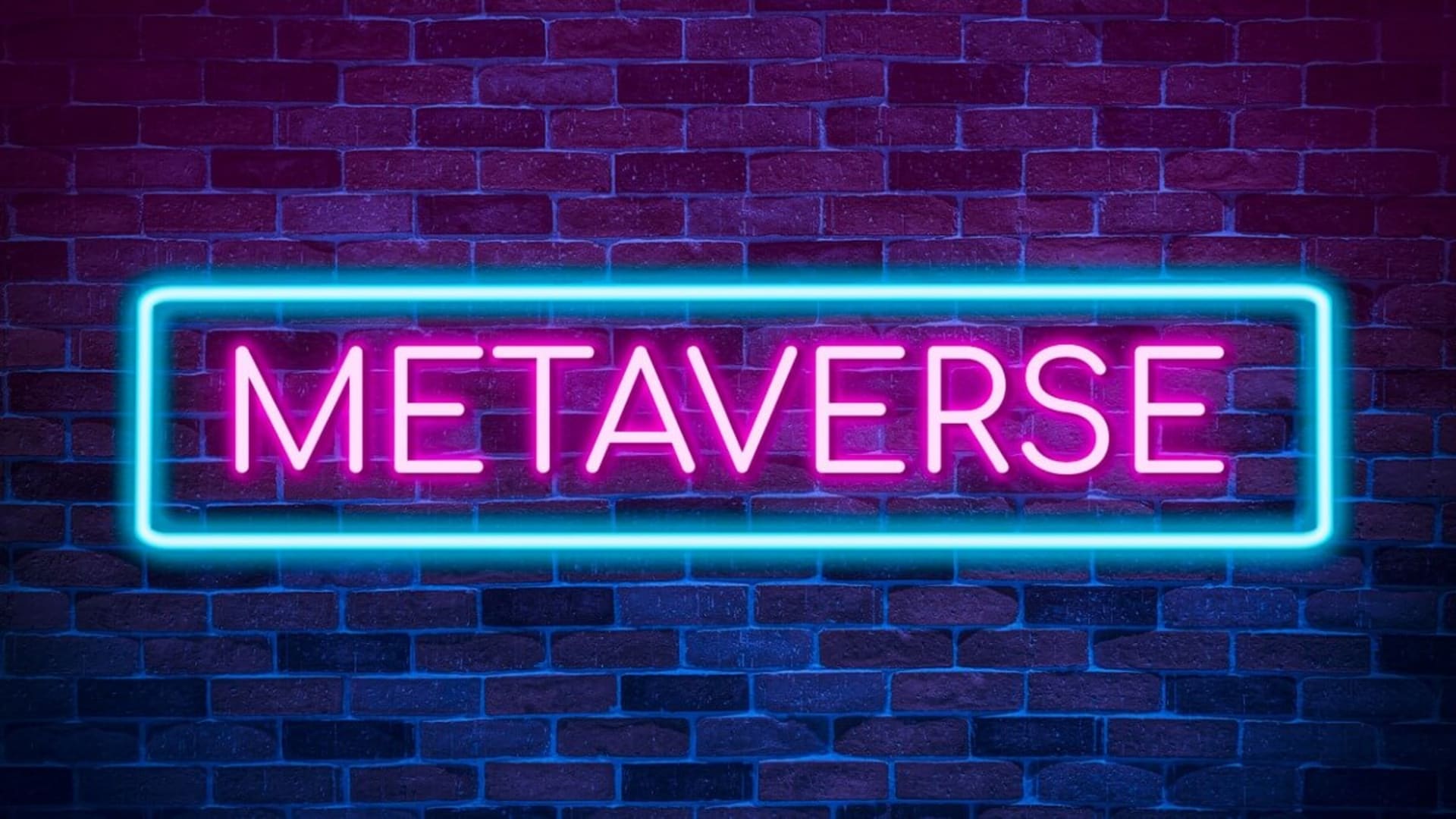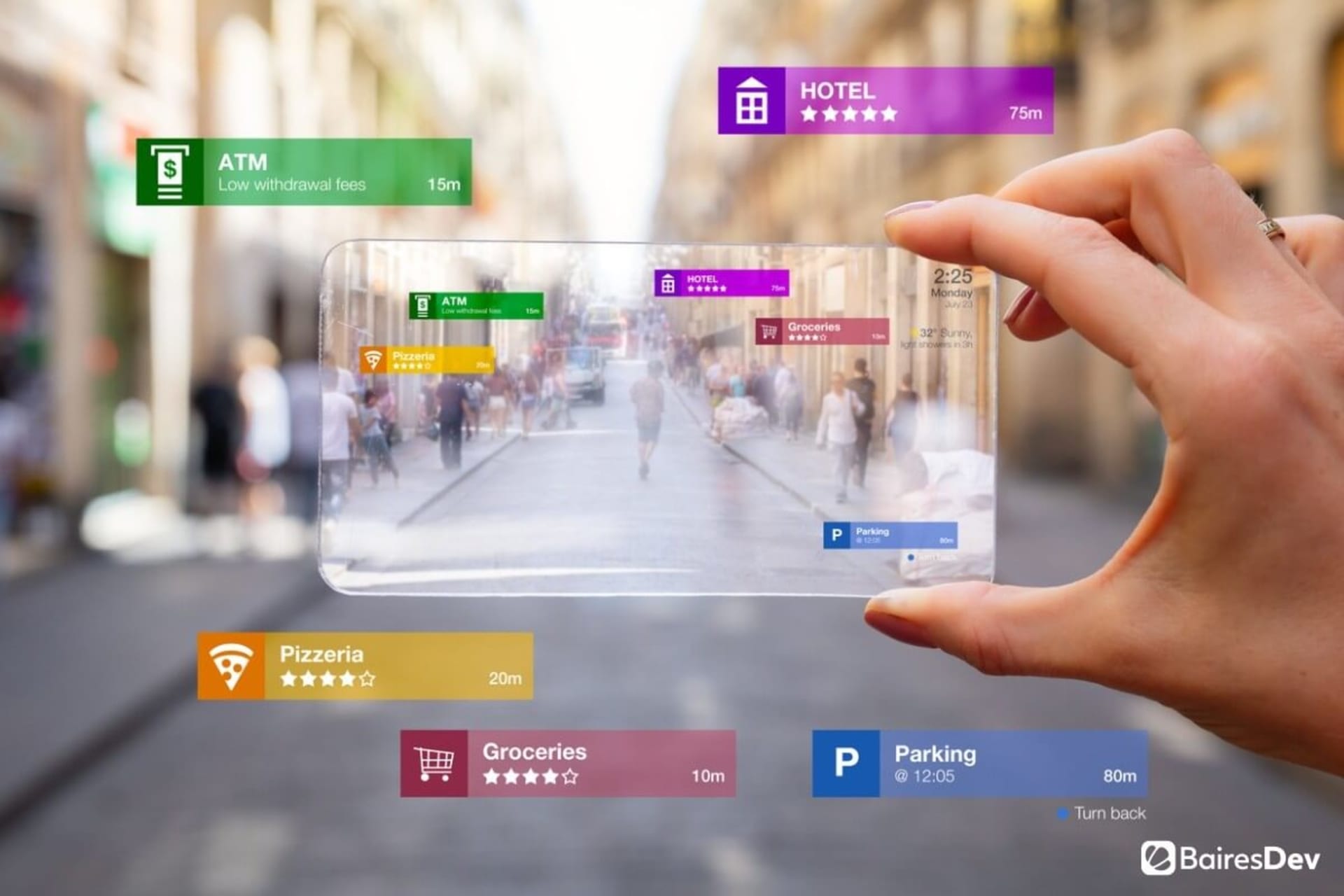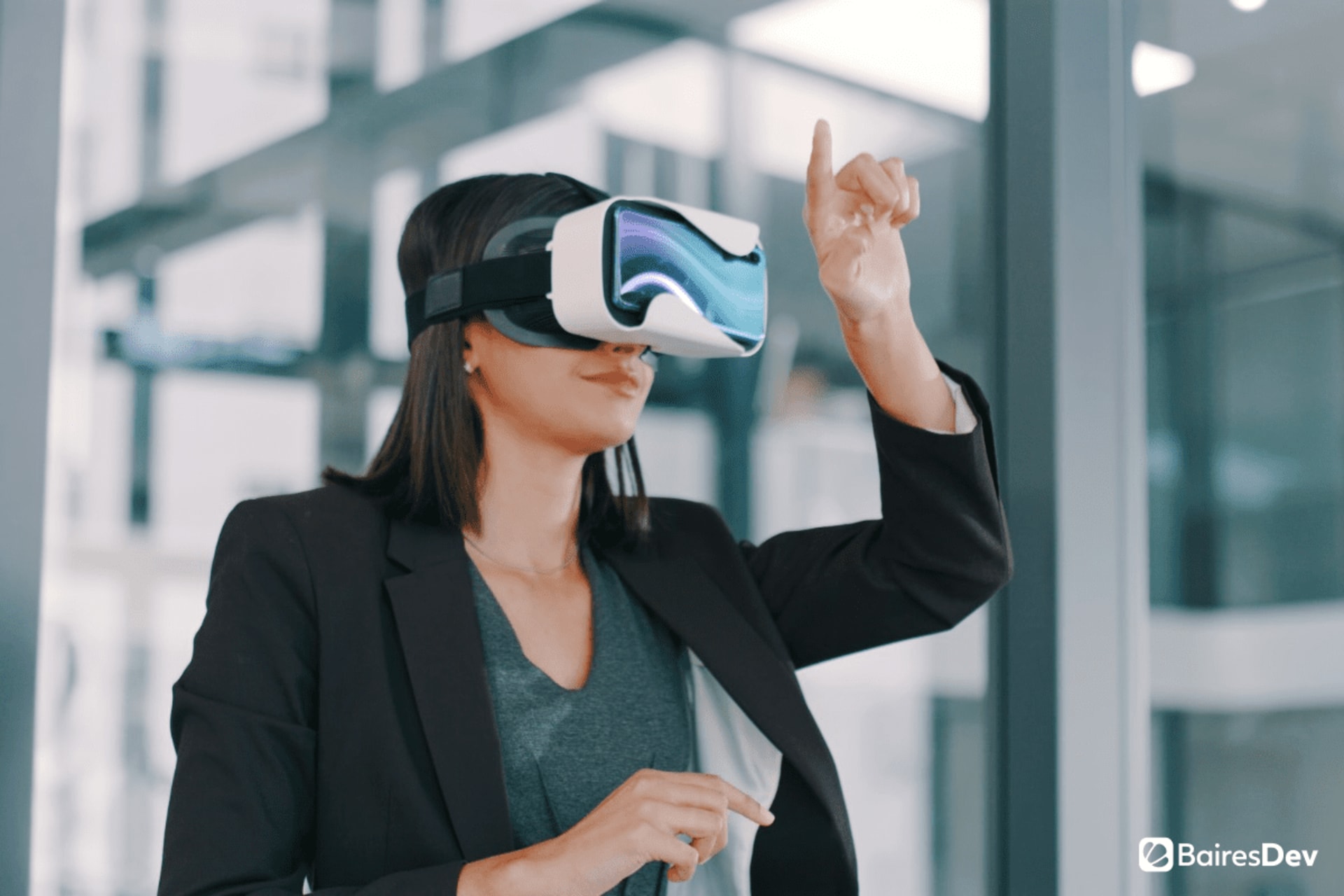Augmented Reality Development Company
Partner with the top 1% of LatAm talent. Delight audiences with AR software solutions.
500+ companies rely on our top 1% tech talent.
Augmented Reality Development Services We Provide
Custom AR Application Design & Development
Create AR games that encourage exploration. Enhance museums and cultural institutions with interactive exhibitions, overlaying facts onto displays via apps. Add digital graffiti to real-world locations. Augmented reality apps blend the physical and digital worlds and create immersive experiences for diverse audiences.
Our custom AR app development services span a range of industries. We use tools like ARKit for iOS and ARCore for Android to enhance apps with AR features.
Augmented Reality Integration & Deployment
Integrate AR technology into a variety of environments and devices, from mobile and web to wearables and sensors.
Using SDKs like ARKit, ARCore, Vuforia, and Unity AR Foundation, along with additional tools such as Blender for 3D modeling, we integrate AR capabilities into software solutions for a user-friendly experience.
Custom AR Experiences for Events & Marketing
Product launches. Live events. Brand activations. Virtual try-ons. AR development provides new and interactive ways for businesses to connect with audiences.
We use AR SDKs, 3D modeling and animation software, content management systems, prototyping tools, and other tools to create AR experiences that event organizers and marketers can use to appeal to their target audiences.
AR for Training & Education
With AR solutions, learners can explore the solar system, time travel through centuries, and interact with 3D models of chemical elements. Businesses can train employees on how to operate complex machinery and respond to emergency scenarios—all without leaving their seats.
Our developers help you create a digital world. We build gamified learning platforms, remote collaboration platforms, customized and interactive textbooks, and other AR educational software with AR SDKs and platforms.
AR for Retail & E-commerce
Allow customers to "try on" retail items. Enable 3D product visualizations. Provide interactive user manuals. Many retailers across niches are turning to AR development to attract customers.
From AR-enabling shopping windows to personalized recommendations, we build software that offers more engaging and informative shopping experiences. Along with AR SDKs, we used tools like Adobe Aero for content creation and 8th Wall for web AR development to facilitate immersion across different platforms.
AR Visualization for Architecture & Real Estate
Offer virtual property tours with immersive walkthroughs and interactive models. Create virtual mockups and collaborative designs. AR visualization transforms architecture and real estate, providing innovative ways of marketing and visualizing properties.
We build the tools that allow you to create virtual mockups, enhanced design platforms, and interactive tours. Technologies like Matterport allow us to build 3D virtual tours and enhance them with AR, while game engines such as Unity or Unreal Engine enable us to deliver interactive, 3D models for engaging experiences.
AR Solutions for Healthcare & Medical Training
In the healthcare and medical field, AR facilitates surgical visualizations, enhanced diagnostics, procedure demonstrations, and more.
Along with standard AR SDKs and tools, we use additional technologies to create healthcare-oriented and HIPAA-compliant software. For example, we build applications that pair with Microsoft HoloLens, a mixed reality headset that leverages AR and virtual reality (VR) to overlay holographic information onto the physical world.
AR for Industrial & Manufacturing Processes
Enhance safety and accuracy, reduce errors, and train employees more effectively. AR technology is used for industrial and manufacturing processes like maintenance and repair, prototyping, and guided assembly.
We facilitate data-driven and interactive operations. From AR SDKs to AWS IoT Core for IoT integrations, we use a range of tools and processes to design and develop software that streamlines and improves manufacturing and industrial processes.
Rolls Royce case study

Key Things to Know About Augmented Reality
Best Practices for Augmented Reality development
For AR, it's crucial to ensure that user interactions are natural and seamless. We develop user interfaces that are intuitive and easy to navigate.
We design and develop software with AR elements that enhance the user experience and add value to the user journey and understanding. That means that the AR application is engaging and useful, rather than overwhelming or disorienting.
AR technology must account for user differences and diverse abilities. With accessibility guidelines and standards like WCAG, we follow universal design principles and include numerous ways to interact with our platforms. We also provide customization options according to your requirements and test the software with diverse users.
We test AR designs across a variety of platforms and environments. Those may include physical environments such as various lighting conditions and surfaces, high and low-bandwidth environments, different geographies, hardware, and operating systems.
Optimizing for performance and battery life is critical for providing a positive user experience. We employ practices like using efficient rendering techniques, offloading processing to the cloud when network conditions allow, and managing sensor usage.
Frameworks and libraries provide developers with a set of pre-built functionalities to reduce development complexity and time. Depending on the project requirements, we use frameworks like ARKit for iOS, ARCore for Android, and Unity's AR Foundation, Vuforia, and Wikitude for cross-platform development.
Spatial audio enhances the sense of presence and immersion for users. We incorporate spatial audio into AR apps to augment the sense that the user is in a 3D space, using specialized audio tools and SDKs.
This is critical for maintaining a seamless user experience, no matter what the tracking conditions. Anticipating AR Tracking failures and implementing error-handling strategies improves the resilience of AR apps.
Engagement is essential for AR software. We develop solutions that provide immersive experiences, incorporate interactive features, offer personalization options, and are accessible, inclusive, and meaningful.
Smooth animations and transitions help users maintain a sense of reality when blending digital and physical environments. Optimizing performance, leveraging AR SDKs and engines, implementing interpolation, and prioritizing user interaction are just some of the strategies we use to build smooth and responsive experiences.
We leverage cloud services, modular design, responsive and adaptive UI/UX, performance optimization techniques, user testing, and other strategies to ensure that AR content is scalable and adaptable. This is crucial for maintaining a consistent user experience across devices and environments.
We thoroughly test user interactions to assess how easily and effectively users can navigate and use the app. We also evaluate how quickly the app responds to user inputs.
Robust security measures are always essential in a digital environment, especially when you're grappling with sensitive data. When we're building AR applications, we prioritize security, using techniques and tools like data encryption, user authentication and authorization mechanisms, and secure APIs.
In order to comply with data privacy laws and regulations like the GDPR, it's important to implement user consent for data collection. Provide a transparent and easily accessible privacy policy outlining what data you collect and how it's used. Implement clear consent requests, and minimize collection as much as possible, among other measures.
Account for vulnerabilities and new threats by periodically releasing updates to your AR application. By releasing security patches, you can better protect user data and maintain user trust.
It's important to educate users about AR environment safety so they remain aware of their surroundings while using AR tools. Provide clear warnings, manuals, context-aware prompts, and more to encourage safety and awareness.
Why Choose BairesDev for Augmented Reality Development

Robust Security Measures
AR applications often need to access sensitive information. To protect you and your data, we implement comprehensive security measures, including data encryption, strong authentication mechanisms, code reviews and analysis, anti-tampering mechanisms, and regular testing. We also enforce strict NDAs.
Diverse Range of Solutions
From interactive learning apps and training simulations to virtual try-ons, we create AR software solutions across industry sectors. Our top 1% talent isn't limited to software developers; our UX/UI designers, QA engineers, project managers, and other professionals can help you deliver immersive and engaging AR experiences.
Flexible Engagement Models
We offer three engagement models to meet a variety of needs: staff augmentation, dedicated teams, and end-to-end software outsourcing. That means that you'll be well-equipped to build your AR software solutions, whether you need one developer with niche expertise or an entire team.
Our process. Simple, seamless, streamlined.
During our first discussion, we'll delve into your business goals, budget, and timeline. This stage helps us gauge whether you’ll need a dedicated software development team or one of our other engagement models (staff augmentation or end-to-end software outsourcing).
We’ll formulate a detailed strategy that outlines our approach to backend development, aligned with your specific needs and chosen engagement model. Get a team of top 1% AR specialists working for you.
With the strategy in place and the team assembled, we'll commence work. As we navigate through the development phase, we commit to regularly updating you on the progress, keeping a close eye on vital metrics to ensure transparency and alignment with your goals.
Frequently Asked Questions
How does augmented reality differ from virtual reality?
AR and VR are both immersive technologies, but they differ in terms of user experience, equipment requirements, and use cases. AR overlays digital content onto the real world to alter the user's perception of their environment. It effectively blends the physical world with the digital world. Typically, AR is experienced through devices like AR glasses, smartphones, or tablets. It is used across industries for purposes like virtual clothing try-ons.
VR fully immerses the user into a completely virtual environment such that they are disconnected from their physical environment. It requires specialized hardware, such as VR headsets, controllers, and, in some cases, body-tracking devices. It's used in scenarios like immersive gaming, virtual tours, and training simulations.
Mixed reality blends elements of both AR and VR. Essentially, MR involves incorporating elements of both types of environments where physical and digital objects exist together and interact in real-time.
What are the benefits of outsourcing AR development services?
Outsourcing AR development offers several benefits. Examples of advantages include:
- Access to specialized expertise
- Faster time to market
- Risk mitigation
- Greater flexibility and scalability
- Cost-effectiveness
How Businesses Can Overcome the Software Development Shortage
BairesDev Ranked as one of the Fastest-Growing Companies in the US by Inc. 5000

See how we can help.Schedule a Call










